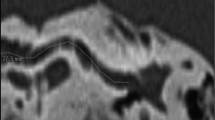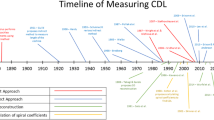Abstract
Purpose
Patient specific selection of cochlear implants would benefit from pre-operative knowledge of cochlear length. Several methods for its measurement or estimation have been described in literature. This study focused on the achievable accuracy in clinically available imaging.
Methods
Five simplified cochlea models milled into porcine bone were scanned in water using clinical cone beam computed tomography. Due to their well-known dimensions these phantoms served as gold standard for the length measurements. Each phantom was measured ten times using the custom software Comet. In addition, cochleae in ten image datasets taken indiscriminately from clinical routine were measured ten times each to test the precision under realistic conditions. The results were also compared to estimations based on the diameter of the basal turn (A value) as described in literature.
Results
Measurement accuracy of the phantoms’ lengths was high (average error: − 0.2 mm; standard deviation: 0.3 mm). The pooled standard deviation for the measurements in clinical datasets was 0.6 mm. Errors resulted mainly from problems locating the helicotrema. The estimations differed on average − 1.7 to + 0.4 mm from the manual measurements and had standard deviations between 0.5 and 0.6 mm depending on the algorithm.
Conclusions
The program Comet was successfully used to accurately measure the length of the cochlea models in clinically available imaging. The lower image quality of patient scans reduced the precision of the measurement. Estimations using the A value are a quicker alternative for averagely sized cochleae in cases where the lack of accuracy is tolerable.





Similar content being viewed by others
References
Roland PS, Wright CG (2006) Surgical aspects of cochlear implantation: mechanisms of insertional trauma. Adv Otorhinolaryngol 64:11–30. https://doi.org/10.1159/000094642
Verberne J, Risi F, Campbell L, Chambers S, O’Leary S (2016) The effect of scala tympani morphology on basilar membrane contact with a straight electrode array. Otol Neurotol 38:47–53. https://doi.org/10.1097/MAO.0000000000001259
Hardy M (1938) The length of the organ of Corti in man. Am J Anat 62:291–311. https://doi.org/10.1002/aja.1000620204
Ulehlová L, Voldrich L, Janisch R (1987) Correlative study of sensory cell density and cochlear length in humans. Hear Res 28:149–151. https://doi.org/10.1016/0378-5955(87)90045-1
Adunka O, Unkelbach MH, Mack MG, Radeloff A, Gstoettner W (2005) Predicting basal cochlear length for electric-acoustic stimulation. Arch Otolaryngol Head Neck Surg 131:488–492. https://doi.org/10.1001/archotol.131.6.488
Würfel W, Lanfermann H, Lenarz T, Majdani O (2014) Cochlear length determination using cone beam computed tomography in a clinical setting. Hear Res 316:65–72. https://doi.org/10.1016/j.heares.2014.07.013
Johnston JDA, Scoffings D, Chung M, Baguley D, Donnelly NP, Axon PR, Gray RF, Tysome JR (2016) Computed tomography estimation of cochlear duct length can predict full insertion in cochlear implantation. Otol Neurotol 37:223–228. https://doi.org/10.1097/MAO.0000000000000955
Meng J, Li S, Zhang F, Li Q, Qin Z (2016) Cochlear size and shape variability and implications in cochlear implantation surgery. Otol Neurotol 37:1307–1313. https://doi.org/10.1097/MAO.0000000000001189
Mistrík P, Jolly C (2016) Optimal electrode length to match patient specific cochlear anatomy. Eur Ann Otorhinolaryngol Head Neck Dis 133:S68–S71. https://doi.org/10.1016/j.anorl.2016.05.001
Koch RW, Elfarnawany M, Zhu N, Ladak HM, Agrawal SK (2017) Evaluation of cochlear duct length computations using synchrotron radiation phase-contrast imaging. Otol Neurotol 38:1. https://doi.org/10.1097/MAO.0000000000001410
Lexow GJ, Rau TS, Gellrich N-C, Lenarz T, Majdani O (2015) Cochlea-Längenmessung in rotierenden, midmodiolaren Schichtansichten—Darstellung der Methode. In: Hahn HK, Kikinis R, Klein J et al (eds) Proc. 14. Jahrestagung der Deutschen Gesellschaft für Computer- und Roboterassistierte Chirurgie (CURAC). Fraunhofer MEVIS, Bremen, pp 335–336
Lexow GJ, Schurzig D, Gellrich N-C, Lenarz T, Majdani O, Rau TS (2016) Visualization, measurement and modelling of the cochlea using rotating midmodiolar slice planes. Int J Comput Assist Radiol Surg. https://doi.org/10.1007/s11548-016-1374-7
Van Wermeskerken GKA, Prokop M, Van Olphen AF, Albers FWJ (2007) Intracochlear assessment of electrode position after cochlear implant surgery by means of multislice computer tomography. Eur Arch Otorhinolaryngol 264:1405–1407. https://doi.org/10.1007/s00405-007-0389-7
Lecerf P, Bakhos D, Cottier J-P, Lescanne E, Trijolet JP, Robier A (2011) Midmodiolar reconstruction as a valuable tool to determine the exact position of the cochlear implant electrode array. Otol Neurotol 32:1075–1081. https://doi.org/10.1097/MAO.0b013e318229d4dd
Malherbe TK, Hanekom T, Hanekom JJ (2016) Constructing a three-dimensional electrical model of a living cochlear implant user’s cochlea. Int J Numer Method Biomed Eng 32:e02751. https://doi.org/10.1002/cnm.2751
Escudé B, James C, Deguine O, Cochard N, Eter E, Fraysse B (2006) The size of the cochlea and predictions of insertion depth angles for cochlear implant electrodes. Audiol Neurotol 11:27–33. https://doi.org/10.1159/000095611
Alexiades G, Dhanasingh A, Jolly C (2015) Method to estimate the complete and two-turn cochlear duct length. Otol Neurotol 36:904–907. https://doi.org/10.1097/MAO.0000000000000620
Avci E, Nauwelaers T, Lenarz T, Hamacher V, Kral A (2014) Variations in microanatomy of the human cochlea. J Comp Neurol 522:3245–3261. https://doi.org/10.1002/cne.23594
Verbist BM, Skinner MW, Cohen LT, Leake PA, James C, Boëx C, Holden TA, Finley CC, Roland PS, Roland JT, Haller M, Patrick JF, Jolly CN, Faltys MA, Briaire JJ, Frijns JHM (2010) Consensus panel on a cochlear coordinate system applicable in histologic, physiologic, and radiologic studies of the human cochlea. Otol Neurotol 31:722–730. https://doi.org/10.1097/MAO.0b013e3181d279e0
Advanced Bionics (2005) HiRes90k Surgeon’s Manual. https://www.advancedbionics.com/content/dam/advancedbionics/Documents/libraries/Audiologists-&-Surgeons-Library/Surgical-Manuals-&-Catalogs/hires-90k-surgeons-manual-hifocus-helix-1j.pdf. Accessed 19 Feb 2018
MED-EL (2013) Electrode arrays: designed for atraumatic implantation providing superior hearing performance. http://www.medel.com/data/pdf/21617.pdf. Accessed 19 Feb 2018
Cochlear (2014) Cochlear Nucleus CI422 with Slim Straight - Technical Specifications. http://www.cochlear.com/wps/wcm/connect/e9bc4ab6-8b75-4cf4-bcda-fb7b2757efbb/FUN1356+ISS2+MAR14+CI422+Specifications+3.pdf?MOD=AJPERES. Accessed 19 Feb 2018
Martinez-Monedero R, Niparko JK, Aygun N (2011) Cochlear coiling pattern and orientation differences in cochlear implant candidates. Otol Neurotol 32:1086–1093. https://doi.org/10.1097/MAO.0b013e31822a1ee2
Erixon E, Rask-Andersen H (2013) How to predict cochlear length before cochlear implantation surgery. Acta Otolaryngol 133:1258–1265. https://doi.org/10.3109/00016489.2013.831475
Yoo SK, Wang G, Rubinstein JT, Vannier MW (2000) Three-dimensional geometric modeling of the cochlea using helico-spiral approximation. IEEE Trans Biomed Eng 47:1392–1402. https://doi.org/10.1109/10.871413
Rivas A, Cakir A, Hunter JB, Labadie RF, Zuniga MG, Wanna GB, Dawant BM, Noble JH (2017) Automatic cochlear duct length estimation for selection of cochlear implant electrode arrays. Otol Neurotol 38:339–346. https://doi.org/10.1097/MAO.0000000000001329
Franke-Trieger A, Mürbe D (2015) Estimation of insertion depth angle based on cochlea diameter and linear insertion depth: a prediction tool for the CI422. Eur Arch Otorhinolaryngol 272:3193–3199. https://doi.org/10.1007/s00405-014-3352-4
Acknowledgements
The presented work was supported by the German Research Foundation (DFG) through the cluster of excellence “Hearing4all” EXC 1077/1 and by the German Federal Ministry of Education and Research (BMBF, FKZ 13GW0019E). Responsibility for the contents of this publication lies with the authors.
Author information
Authors and Affiliations
Corresponding author
Ethics declarations
Conflict of interest
G. Jakob Lexow, Marcel Kluge, Nils-Claudius Gellrich, Thomas Lenarz, Omid Majdani and Thomas S. Rau declare that they have no conflict of interest.
Ethical approval
This article does not contain any studies with human participants or animals performed by any of the authors.
Rights and permissions
About this article
Cite this article
Lexow, G.J., Kluge, M., Gellrich, NC. et al. On the accuracy of cochlear duct length measurement in computed tomographic images. Eur Arch Otorhinolaryngol 275, 1077–1085 (2018). https://doi.org/10.1007/s00405-018-4930-7
Received:
Accepted:
Published:
Issue Date:
DOI: https://doi.org/10.1007/s00405-018-4930-7




